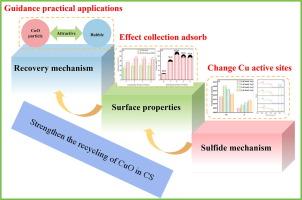当前位置:
X-MOL 学术
›
Appl. Surf. Sci.
›
论文详情
Our official English website, www.x-mol.net, welcomes your
feedback! (Note: you will need to create a separate account there.)
Surface sulfidization mechanism of difficult to enrich copper oxide in copper smelting slag and its response to recycling performance
Applied Surface Science ( IF 6.3 ) Pub Date : 2024-11-19 , DOI: 10.1016/j.apsusc.2024.161825 Xingcai Yu, Qicheng Feng, Han Wang, Dianwen Liu
Applied Surface Science ( IF 6.3 ) Pub Date : 2024-11-19 , DOI: 10.1016/j.apsusc.2024.161825 Xingcai Yu, Qicheng Feng, Han Wang, Dianwen Liu

|
Copper oxide (CuO) is a key component of the oxidized fraction of copper slag (CS). The recovery of CS has been targeted only at the sulfide fraction, with the recovery of the oxidized fraction not sufficiently studied. CuO has chemical properties analogous to but different from copper oxide minerals. Sodium sulfide (Na2S) is a typical activator of copper oxide minerals. The sulfization mechanism of Na2S on CuO and its effect on collection adsorption were investigated in this study. The primary mechanism of CuO activation is an increase in the Cu active sites, yielding a more effective activated surface by using an appropriate Na2S concentration. When the Na2S concentration is extremely high, S continues to adsorb onto CuO surface, which covers the Cu sites, resulting in its depression. The recyclability of the modified CuO is improved owing to the improved adsorption of sodium butyl xanthate (SBX) and the enhanced interaction force between CuO particles and bubbles. At an extremely high Na2S concentration, the SBX adsorbed on CuO surface was weakens and reduced interaction force between CuO particles and bubbles. This study clarifies the activation mechanism of CuO and its effect on CuO recyclability, providing a theoretical basis for practical applications, and provide guidance for the recycling and utilization of copper resources in CS.
中文翻译:

铜冶炼渣中难富集氧化铜的表面硫化机理及其对回收性能的响应
氧化铜 (CuO) 是铜渣 (CS) 氧化部分的关键成分。CS 的回收率仅针对硫化物馏分,氧化馏分的回收率尚未得到充分研究。CuO 的化学性质与氧化铜矿物相似但不同。硫化钠 (Na2S) 是氧化铜矿物的典型活化剂。本研究研究了 Na2S 对 CuO 的硫化机制及其对收集吸附的影响。CuO 活化的主要机制是 Cu 活性位点的增加,通过使用适当的 Na2S 浓度产生更有效的活化表面。当 Na2S 浓度极高时,S 继续吸附到覆盖 Cu 位点的 CuO 表面上,导致其凹陷。由于丁基黄原酸钠 (SBX) 的吸附性得到改善,CuO 颗粒与气泡之间的相互作用力增强,改性后的 CuO 的可回收性得到提高。在极高的 Na2S 浓度下,吸附在 CuO 表面的 SBX 减弱,CuO 颗粒与气泡之间的相互作用力降低。本研究阐明了 CuO 的活化机制及其对 CuO 可回收性的影响,为实际应用提供了理论依据,并为 CS 中铜资源的回收利用提供了指导。
更新日期:2024-11-19
中文翻译:

铜冶炼渣中难富集氧化铜的表面硫化机理及其对回收性能的响应
氧化铜 (CuO) 是铜渣 (CS) 氧化部分的关键成分。CS 的回收率仅针对硫化物馏分,氧化馏分的回收率尚未得到充分研究。CuO 的化学性质与氧化铜矿物相似但不同。硫化钠 (Na2S) 是氧化铜矿物的典型活化剂。本研究研究了 Na2S 对 CuO 的硫化机制及其对收集吸附的影响。CuO 活化的主要机制是 Cu 活性位点的增加,通过使用适当的 Na2S 浓度产生更有效的活化表面。当 Na2S 浓度极高时,S 继续吸附到覆盖 Cu 位点的 CuO 表面上,导致其凹陷。由于丁基黄原酸钠 (SBX) 的吸附性得到改善,CuO 颗粒与气泡之间的相互作用力增强,改性后的 CuO 的可回收性得到提高。在极高的 Na2S 浓度下,吸附在 CuO 表面的 SBX 减弱,CuO 颗粒与气泡之间的相互作用力降低。本研究阐明了 CuO 的活化机制及其对 CuO 可回收性的影响,为实际应用提供了理论依据,并为 CS 中铜资源的回收利用提供了指导。


















































 京公网安备 11010802027423号
京公网安备 11010802027423号